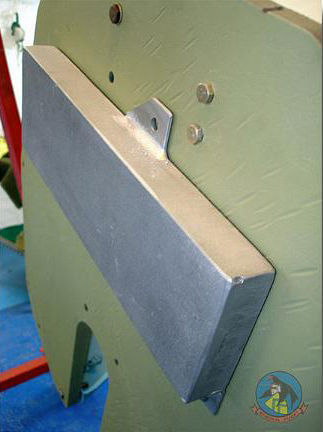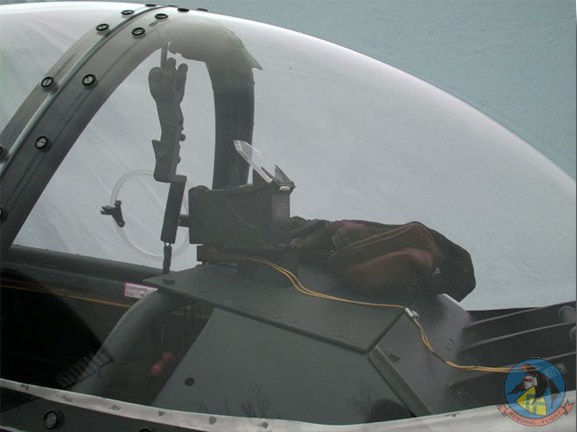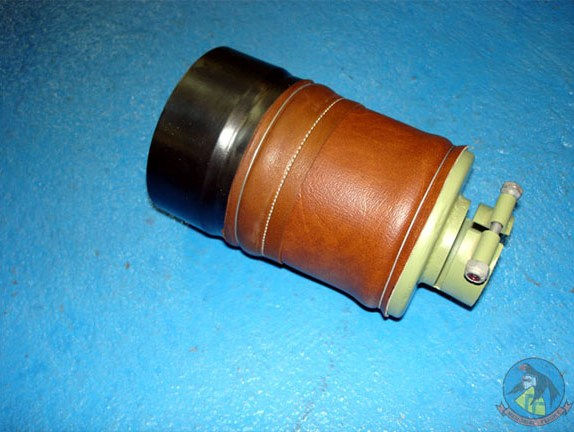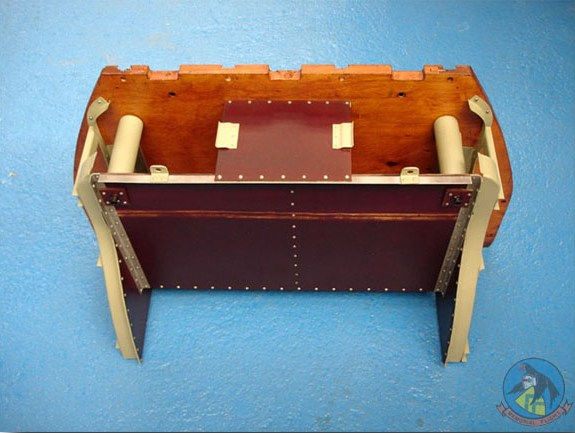

Although an " utopia " of the third Reich, the Volksjäger was in fact a unique and extraordinary airplane:
-
First single engine jet fighter,
-
First single engine jet fighter equiped with an ejection seat,
-
One of the few tricycle gear fighter,
-
The only one built in such a short period of time (3 months) from the drawing board to the prototype.
Nearly 200 were supplied by three assembly factories:
-
Heinkel- Rostock in Maienehe as early as January 45, bearing the werk nummer 120 000 to 120, airplanes of the A-2 version with 20mm guns.
-
Heinkel-Hinterbrühl, end of January 45, 220 000 serie for the pre production planes.
-
Junkers-Bernburg, end of February 45, 310 000 serie for nearly 30 airplanes of the A.1 version, armed with 30 mm guns.
-
A fourth plant (the sinister mittelwerke near the Dora concentration camp) was supposed to produce airplanes of 300 000 serie, but production switched to V1 and V2 retaliation weapons.
Powered by a BMW 003E-1 jet engine (800 kg thrust), the fuselage is metalic while wing, rudders, ailerons, flaps, fuselage doors, and the nose are made of wood. All this woodwork was performed by numerous small workshops spread around the assembly plants. The jet engine is positioned above the fuselage and blows between the two rudders. The fuel tanks are located in the fuselage and in the wing, the latest built as integral fuel tank, by resin impregnation of the wood structure. In case of emergency, an ejection seat was supposed to send the pilot clear of the jet intake.
A sole Group became operational, equiped with about 30 He 162, the I./JG1 was based in Leck near the Danish border during the closing days of the war, from April 16 to May 8 1945.
The airplanes belonging to the Group were involved in some fights such as the loss of Feldwebel Kirchner flying "yellow 2". Another loss happened on April 26 1945, Unteroffizier Rechenbach was shot down above Keck during a fight against a Spitfire. Moreover, a victory claim was made by 2nd Lt Guy F. Cary of the 15th Tactical Reconnaissance Squadron, 10th PRG 9th Airforce on a He 162, 3 km north east of Bernberg, probably an airplane on a ferry or a test flight, from the Jünkers factory. A probable victory by an He 162 (never clearely confirmed) on a Typhoon or Tempest by Lt. Rudolf Schmitt above Rostock flying the "white 1".
The Heinkel 162 n°120015

The Memorial Flight Association has been asked to restore the He 162 nr 120015 on behalf of the Musée de l'Air et de l'Espace. This airplane being one of the last survivors and one the few almost complete.
When the British Forces occupied Leck on May 15 1945, they found 27 He 162 on the airfield. Five were turned over to the French in Feb 1946 ; two A-1 version wnr. 310012 "red 7 " and wnr. 310003 "yellow 5" ; three A-2 version, wnr. 120093 "white 2" , wnr. 120223 "yellow 1" and wnr. 120015. We now know that there wer at least seven aircrafts in France (two more than the official list).
The A-2's were flown with french markings from April 1947 to July 1948. Wnr. 120015 was painted in a single colour of grey/beige and bore the nr. 2. It was flown for most of the tests totalling nearly 14 hours on a total amount of 18 hours of flight tests ; each flight lasting approximately 20 to 30 mn ; this enabled about 30 French Air Force pilots to get a glimpse of jet flying, pending the arrival of British Vampires in 1949.
Grounded after the death of Capt. Schienger on the nr 1, the 120015 was sent to the Rochefort-Sur-Mer Air Force mechanics school. It was then repainted "bordeaux-red" and set to the Musée de l'Air et de l'Espace in 1952 ; its colour changed again to dark green until 1975 when it was given an approximate camouflage paint posing as wnr. 120223.
The Restoration
Restoration Details
Video: Landing gear test
After 60 years, the landing gear is alive again.
Photoscope
The FUG24 radio and the FUG25a IFF (cockpit).
Photoscope
The FUG24 radio and the FUG25a IFF (rear fuselage).
Photoscope
The cockpit.
Photoscope
The canopy.
Photoscope
The front landing gear bay.
Photoscope
The main landing gear bay.
Photoscope
The armament bay.
Photoscope
The MG151-20 20mm gun.
Photoscope
The parachute.
Photoscope
The pilot gear.
Photoscope
The gunsight :
This model is the standard REVI 16B (without sunshield) installed on all He 162.
The pilot could switch from white to red crosshair.
Photoscope
The flare gun.
Photoscope
The tail section :
The camouflage of the tail section correspond to the Oberflächenschutzliste 8-162 of 9 january 1945, that is RLM 81,82 and 76 painted in sub assemblies.
Photoscope
The main landing gear:
Interesting detail: the left and right gears are different.
The right one of a late Me109 (G10-K4) models is RLM 66. The significance of the hand painted black stripe is unknown.
The left gear of an earlier Me 109 model (...-G6) is RLM 76. The top of the left leg, of a different type, is painted RLM 02 and its stub axle is lenghtened to accept the 660x190 wheel.
Note the difference between the 2 hydraulic pipings.
Photoscope
The front landing gear.
Photoscope
The wing :
The camouflage and markings are correct for N°120015 and should not be taken as standard for all He162.
A future publication dealing with the complete restauration of 120015 is planned; It will include the camouflage and markings in german and french use, along with a revised set of plans and much more.
The top is RLM 70 and the bottom RLM 65.
After a thorought record of each layer of paint and the discovery of all the french and german markings, here is the wing during the final paint stripping showing its particular wood construction.
Photoscope
The engine (BMW 003).
The video show how the exhaust cone works.

He162 Exhaust cone
Photoscope
The Riedel (starter).
Photoscope
The ammo box.
Photoscope
The ejection seat.
Pieces of history
The restoration of such an old machine is also an opportunity to rediscover its history.
Confirmed identity
After many years of wandering, the He 162 from the Musée de l'Air et de l'Espace reveals its true identity. It is an early model of the first batch built under the RLM number 120015.
Pencil writing
During the landing gear bay restoration process, we found this pencil writing.
We can read the name and address of a man who apparently worked on this aircraft.
LUBCZINSKI
WERNER
SANDERSDORF / KRS/
BITTERFELD
We would like to know more about this man or his family, as it is a fantastic part of the history of 120015.
This is also a reminder, planes are not just beautiful pieces of engineering.
If you can get information, contact us.

Specifications
Length: 9.05m
Wing span: 7 .20m
Weight (full charge): 2695 kg
Engine : 1x 800kgf BMW 003E-1 jet engine
Speed : 840 km/h
Endurance : 975 km
Crew : 1
Armament : 2 20mm MG151 Mauser guns
Pressbook
Article: Heinkel 162 / Flugzeug (german, octobre 2005), 1 page

Article: Heinkel 162 / Flugzeug (german, novembre 2005), 1 page





























































































































































































































































































































































































